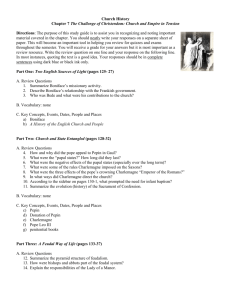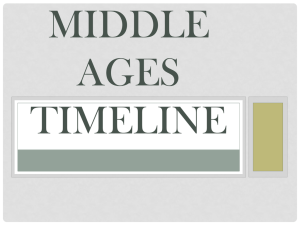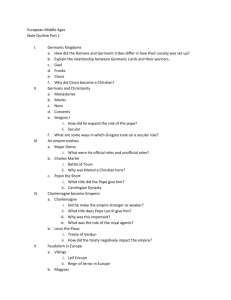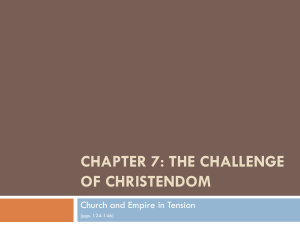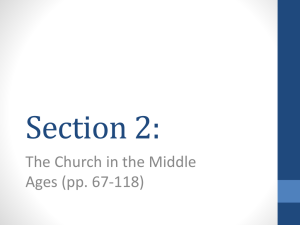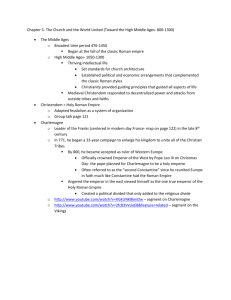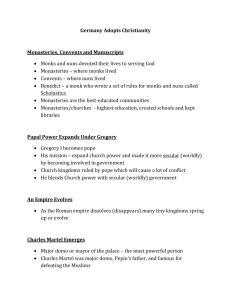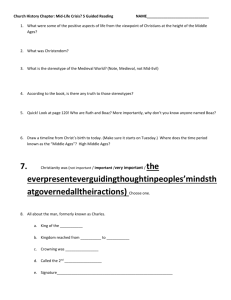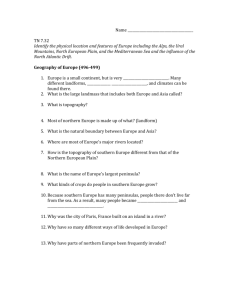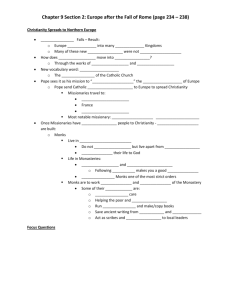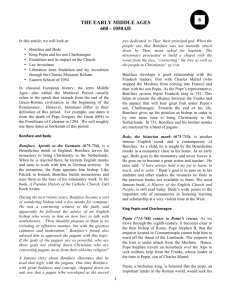Church History November 2012 Test 1 Second Quarter Mr. Langley
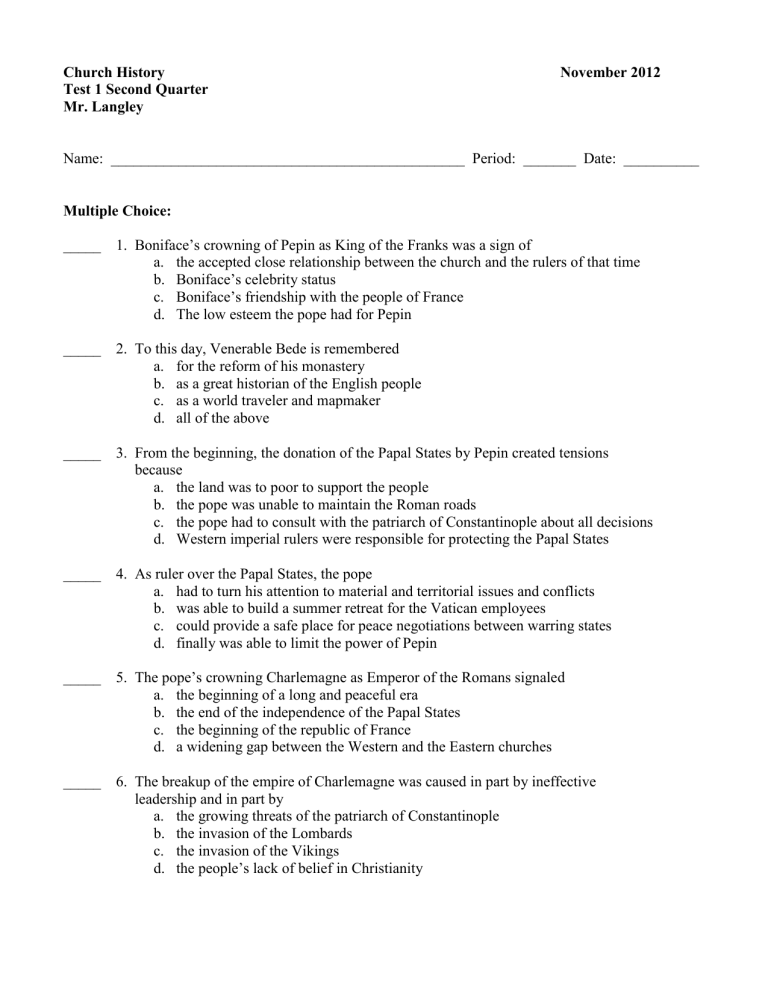
Church History
Test 1 Second Quarter
Mr. Langley
November 2012
Name: _______________________________________________ Period: _______ Date: __________
Multiple Choice:
_____ 1. Boniface’s crowning of Pepin as King of the Franks was a sign of a.
the accepted close relationship between the church and the rulers of that time b.
Boniface’s celebrity status c.
Boniface’s friendship with the people of France d.
The low esteem the pope had for Pepin
_____ 2. To this day, Venerable Bede is remembered a.
for the reform of his monastery b.
as a great historian of the English people c.
as a world traveler and mapmaker d.
all of the above
_____ 3. From the beginning, the donation of the Papal States by Pepin created tensions
because a.
the land was to poor to support the people b.
the pope was unable to maintain the Roman roads c.
the pope had to consult with the patriarch of Constantinople about all decisions d.
Western imperial rulers were responsible for protecting the Papal States
_____ 4. As ruler over the Papal States, the pope a.
had to turn his attention to material and territorial issues and conflicts b.
was able to build a summer retreat for the Vatican employees c.
could provide a safe place for peace negotiations between warring states d.
finally was able to limit the power of Pepin
_____ 5. The pope’s crowning Charlemagne as Emperor of the Romans signaled a.
the beginning of a long and peaceful era b.
the end of the independence of the Papal States c.
the beginning of the republic of France d.
a widening gap between the Western and the Eastern churches
_____ 6. The breakup of the empire of Charlemagne was caused in part by ineffective
leadership and in part by a.
the growing threats of the patriarch of Constantinople b.
the invasion of the Lombards c.
the invasion of the Vikings d.
the people’s lack of belief in Christianity
November 2012 (2)
Multiple Choice (cont.):
_____ 7. Feudalism replaced centralized government because a.
the empire was unable to provide order and security for its subjects b.
the people voted the emperor out of office c.
no one wanted to work in the imperial city d.
labor unions demanded changes the emperor could not make
_____ 8. Under the feudal system, bishops and abbots a.
governed in the same way as their secular counterparts b.
modeled themselves on early Christian communities c.
functioned outside the system d.
established separate, isolated base communities
_____ 9. The Norsemen who pirated the coasts of Northern Europe eventually a.
turned their attention away from Europe to Greenland and Iceland b.
settled exclusively in Northeast Canada c.
settled in parts of France, England, and Ireland d.
withdrew and settled in the countries of Scandinavia
_____ 10. The missionaries Cyril and Methodius eventually converted the Slavic people to
Christianity when they a.
translated the Gospels into the Slavic languages b.
forced the leaders to become Christian c.
tolerated the worship of pagan deities d.
gave valuable artifacts to the Slavic people
_____ 11. Some German bishops’ objections to the use of the Slavic language for Mass led to a.
the development of the Slavic National church b.
Cyril and Methodius’s followers moving into the area known as Bulgaria c.
the bishop’s seceding from the Catholic church d.
the Slavic people’s rejection of Christianity altogether
_____ 12. Vladimir I of Russia followed the accepted practice of his era when he a.
called a popular vote to determine the majority religion b.
granted freedom of religion to all citizens c.
took on the task of choosing a religion for his people d.
commanded historians to research the ethnic and traditional religion of Russia
_____ 13. The monastery at Cluny was unusual because it was a.
free of the influence of feudal lords b.
a profitable wheat-producing fief c.
the only French monastery of men and women d.
the first French monastery that followed the Rule of Saint Basil
November 2012 (3)
Multiple Choice (cont.):
_____ 14. Towns began to be established as the result of a.
kings ordering people to live in communities b.
knights’ discovery of them in the Far East c.
the increase in agriculture production and population increases d.
the boredom of people who lived in isolation
_____ 15. The Concordat of Worms (in Germany) a.
resolved that all bishops would be elected and consecrated by church authority b.
taken with vitamins would stem the Black Death c.
was a body of assorted religious orders d.
forbade the presence of Muslims in Spain
_____ 16. Medieval cathedrals provided space for a.
priests and monks to sing or recite the Divine Office b.
great numbers of people to attend Mass c.
meeting and hiring place for guilds d.
all of the above
_____ 17. The organization of the first universities was modeled on a. guilds b. monasteries c. village fairs d. law courts
_____ 18. At the end of the Dark Ages and the beginning of the High Middle Ages this country
became a source of new light a. France b. Germany c. Italy d. England
_____ 19. The formal deed giving the pope land in Italy which became known as the Papal
States was called a.
iconoclast controversy b.
lay investiture c.
Donation of Pepin d.
Feudalism
_____ 20. One of Charlemagne’s accomplishments was a.
encouraging the construction of Benedictine monasteries b.
attempted to educate and reform the native clergy c.
promoted the adoption of the Latin liturgy used in Rome d.
all of the above
November 2012 (4)
Multiple Choice (cont.):
_____ 21. The political and economic system based on a pyramid structure was a. papacy b. feudalism c. lay investiture d. crusade
_____ 22. The practice by which a high-ranking layperson such as an emperor, king, count, or a
lord could appoint bishops or abbots was called a. feudalism b. lay investiture c. papacy d. simony
_____ 23. During the Dark Ages the people’s dependence on God was balanced by a.
their sense of optimism b.
loyalty to their democratic institutions c.
their awareness of the power of the devil d.
belief in rugged individualism
_____ 24. As a result of the weakening leadership in the Western empire of the 400s, a.
the Laplanders of the North migrated to the South b.
religions were brutally suppressed c.
small barbarian kingdoms became established within the empire d.
Roman citizens began a revolt
_____ 25. The following describes Theodoric: a.
Western, Gothic, Arian b.
Western, Frank, Catholic c.
Western, Italian, Catholic d.
Eastern, Barbarian, pagan
_____ 26. Theodoric’s religious tolerance can be attributed to a.
the influence of his education by Greek scholars b.
his need for the stability and peace the Catholic church could provide c.
the strong and wise influence of Saint Helena d.
the growing threat of the Arians
_____ 27. The Frankish lands were acquired and consolidated under the leadership of a.
Richard the Lionhearted b.
Gregory c.
Clovis d.
Charles Martel
November 2012 (5)
Multiple Choice (cont.):
_____ 28. Like Constantine in the fourth century, the Frankish king’s acceptance of Christianity
occurred because of a.
a military victory attributed to the Christian God b.
the prayers of his Christian mother c.
the exceptional holiness of the conquered people d.
none of the above
_____ 29. Justinian is best known for a.
his tolerance of Jews b.
his marriage to the land-rich ruler Thea c.
his support of monasteries d.
the reform of civil law
_____ 30. Jews before and during Justinian’s reign a.
were allowed to teach economics in the first university established in Rome b.
undertook voyages to the western Mediterranean to find a homeland c.
were persecuted for succeeding in a business Christians considered immoral d.
were helped to practice their religion freely
_____ 31. Gregory is credited with a.
gathering and establishing the liturgical music tradition of the Western church b.
developing the first fund for church organs and organists c.
prohibiting all popular music from church buildings d.
entering into heretical agreements with the Eastern church
_____ 32. One of the most remarkable achievements of the church over the centuries has been
the development of a. Edict of Milan b. monasticism c. cathedrals d. Christian calendar
_____ 33. Saint Benedict is known as a.
the eagle of Monte Cassino b.
the father of Arianism c.
the father of Western Monasticism d.
the ancient one
_____ 34. The Muslim conquest did not reach beyond Spain in the West because of the
resistance of the armies led by a. Muhammad b. Clovis c. Charles Martel d. Gregory the Great
_____ 35. The term referring to Christianity as the dominant and organizational and cultural force in
society is a.
Catholicism. b.
Arianism. c.
Christendom. d.
Monasticism.
November 2012 (6)
Matching:
_____ 36. a Benedictine monk, an untiring traveler
_____ 37. author of, A History of the English Church
and People
_____ 38. French for “Charles the Great”
_____ 39. crowned Charlemagne “Emperor of the Romans”
_____ 40. in the feudal system, the grand landlord of his
region, top of the pyramid
_____ 41. the sin whereas a rich man could buy himself
the office of bishop
_____ 42. An architectural style that is a more horizontal,
Solid appearance
_____ 43. Duke of Aquitane, began a new Benedictine
monastery in Cluny, France
a. simony b. guilds c. universities
d. Boniface
e. College of Cardinals
f. Charlemagne
g. Romanesque
h. king
i. Bede
j. William the Pius
k. Pope Leo III
_____ 44. teachers and students at the cathedral schools
grouping together to study became known as these l. flying buttresses
_____ 45. the forerunners to the trade unions of today
_____ 46. a group established in the Middle Ages, that met
to elect the pope
_____ 47. a major architectural innovation that enabled the
Gothic cathedrals to reach new heights
Fill-in the Blanks:
48. In 476 the Roman empire was deposed by a barbarian leader. After the fall the empire
became known as the _______________ Empire.
49. In the 5 th
century Christianity moved rapidly into a position of strong world influence as the
church developed its moral, ______________, and political leadership.
50. At the time of Clovis, the _______________ was changed from the Roman to the one used
today.
51. In the early Dark Ages (6 th
century) people had little control over ________________, their
environment, or their fate. Most people did not live past the age of forty-five.
November 2012 (7)
Fill-in the Blanks (cont.):
52. Justinian set up a committee that took seven years to produce the _____________________,
a new set of laws that reflected Christian values.
53. Muhammad’s writings known as the Islamic scriptures were called the _______________.
54. By the mid 700s Spain had come under the rule of the Muslims. The aid of the Jews
accounted for the success of the ________________ in Spain.
55. Charles Martel’s victories prevented Islam from spreading over Europe. Martel lived up to
his name, Martel means “the _______________.”
Essay:
Explain how the Church had a major role in shaping Europe during the High Middle Ages.
